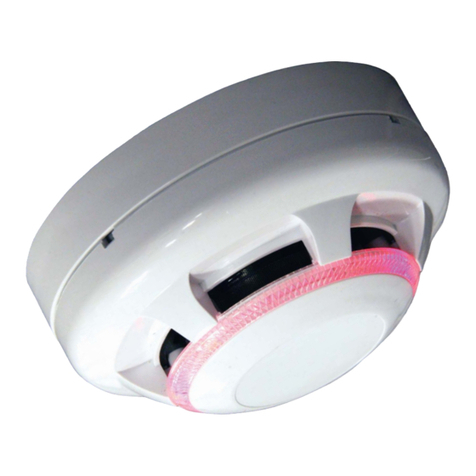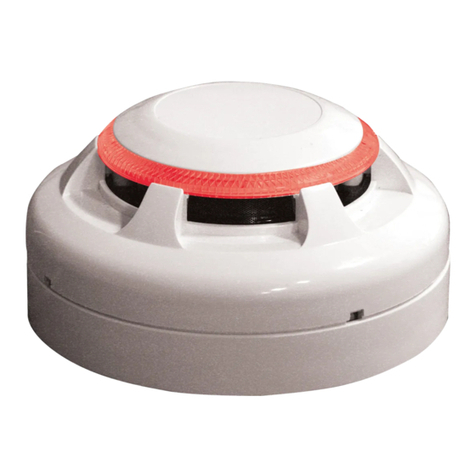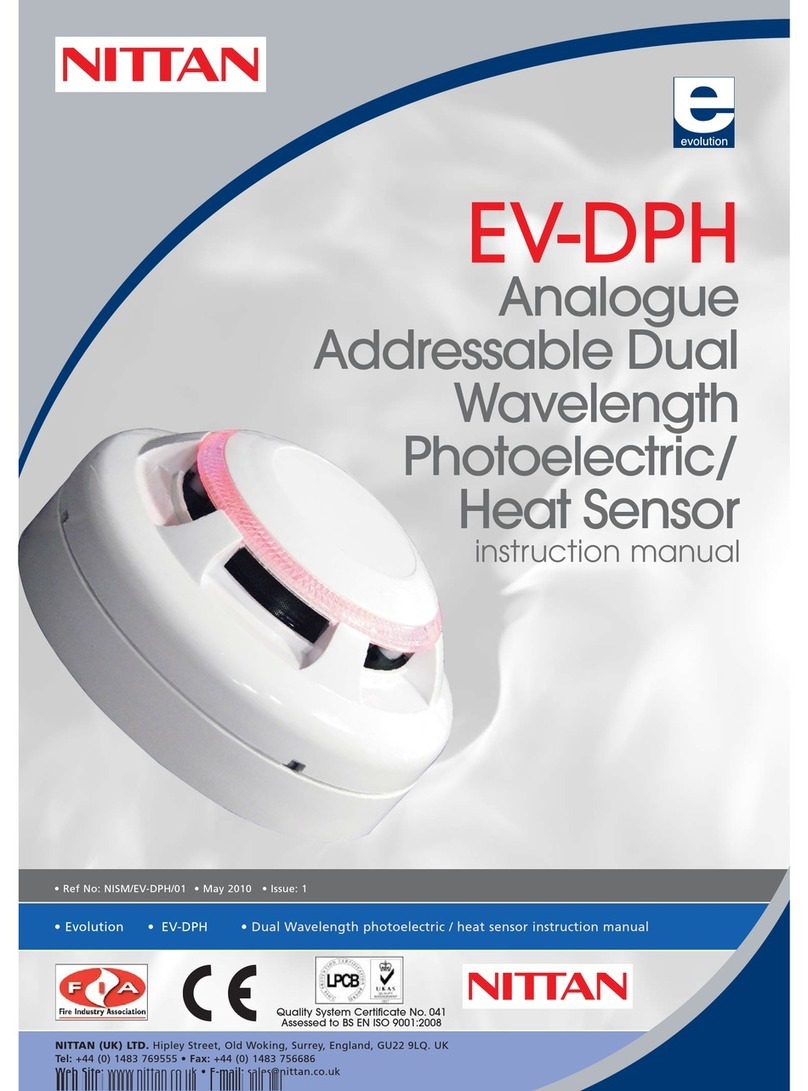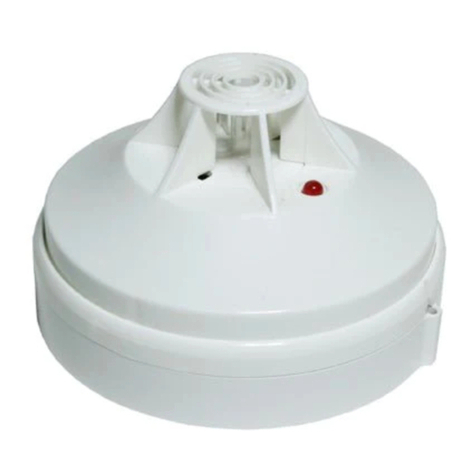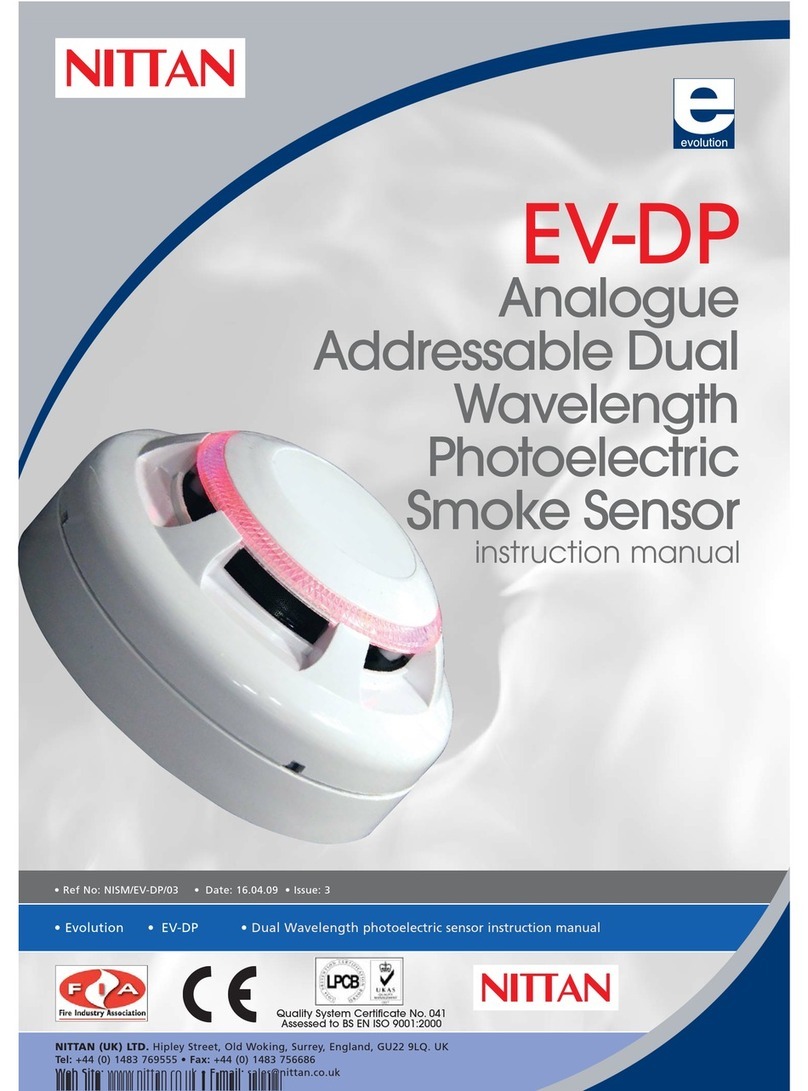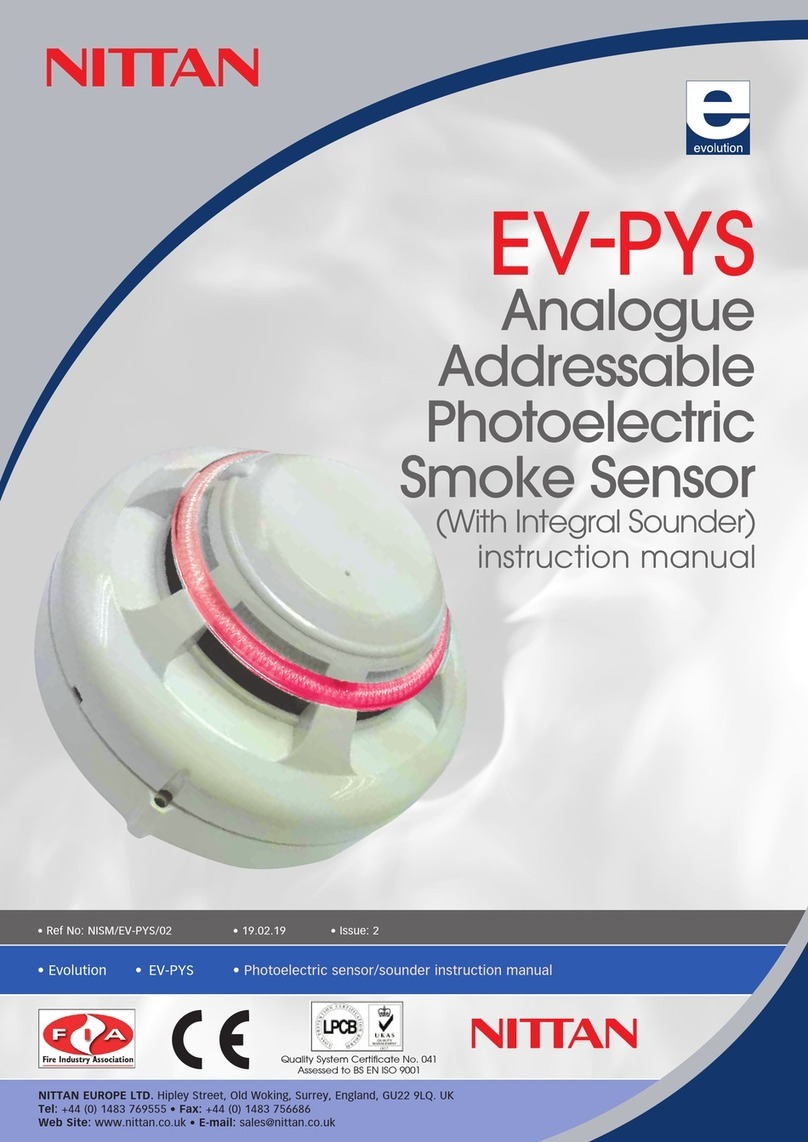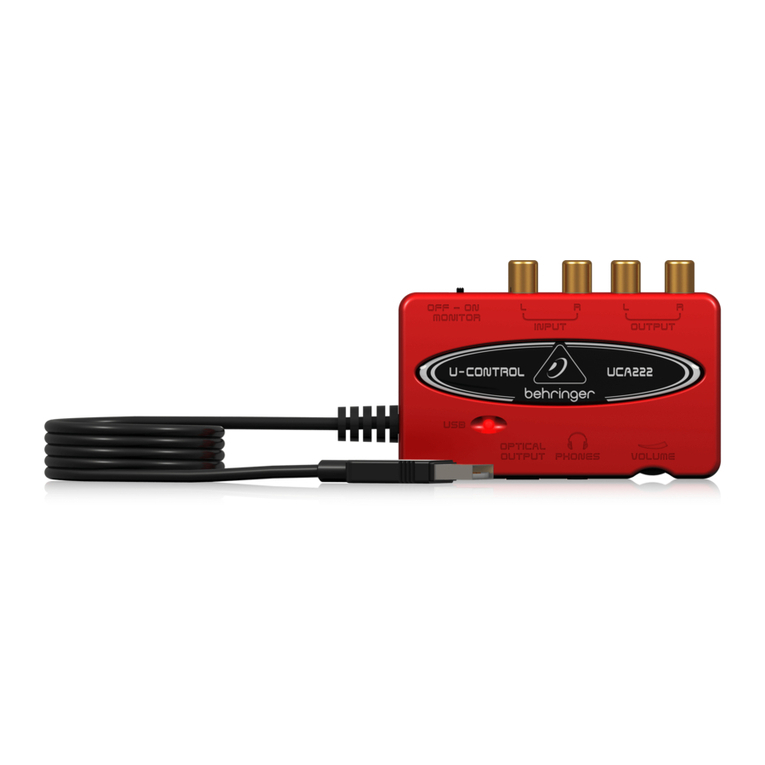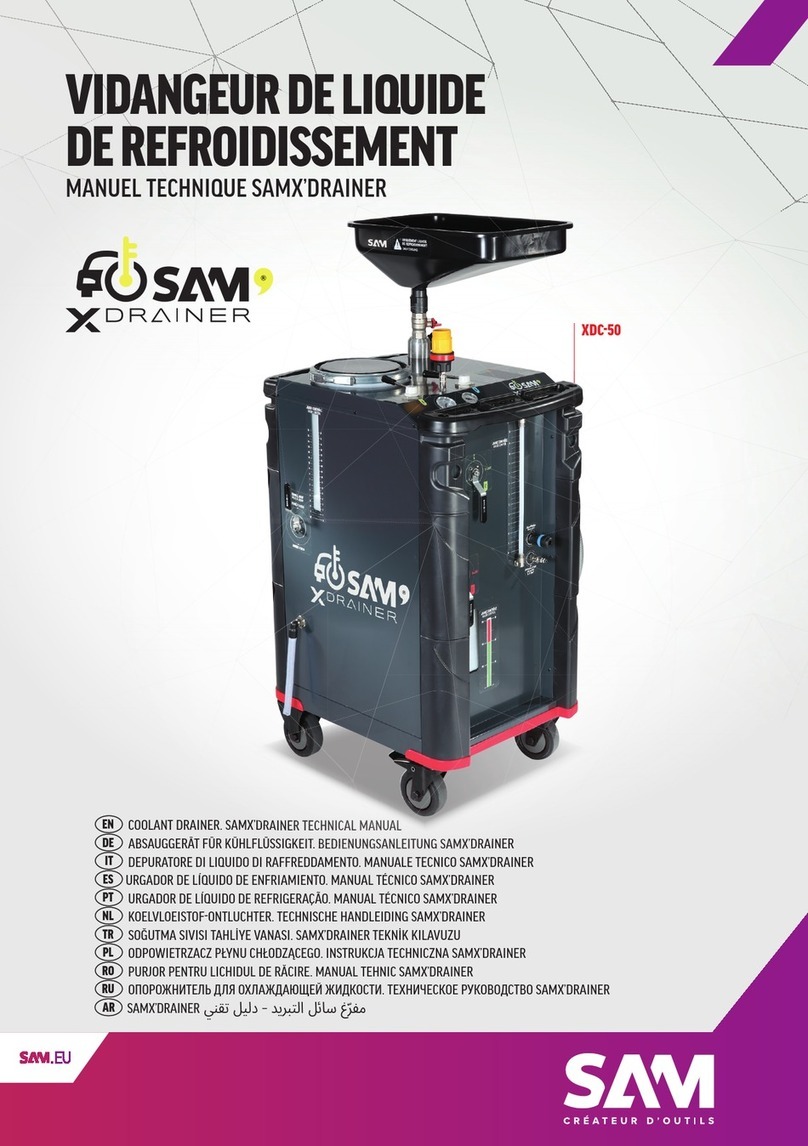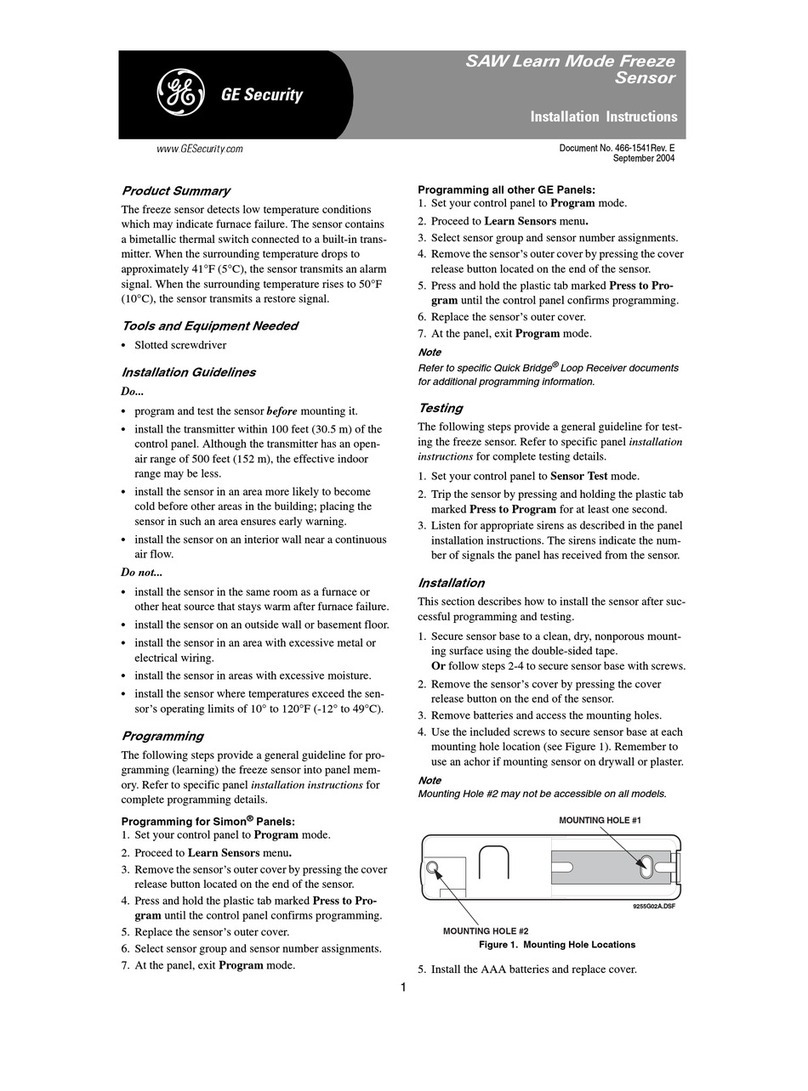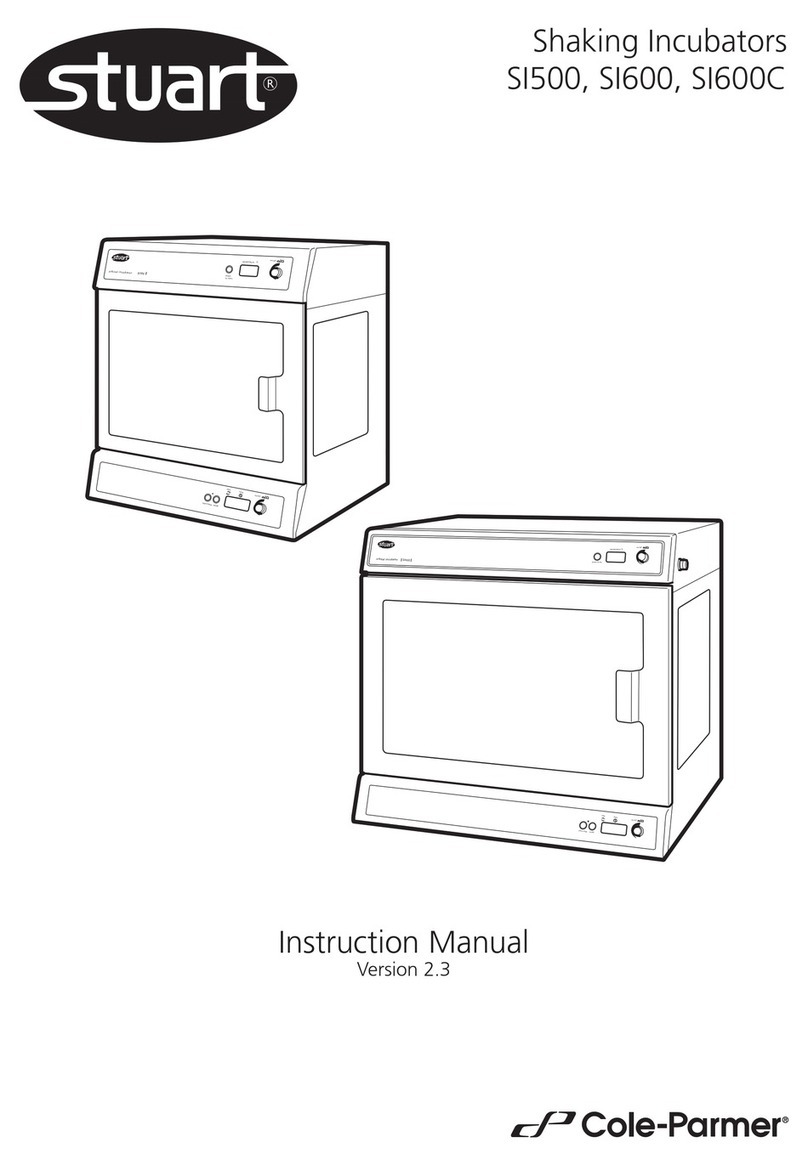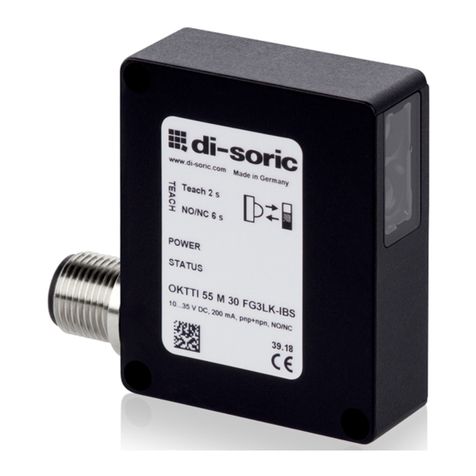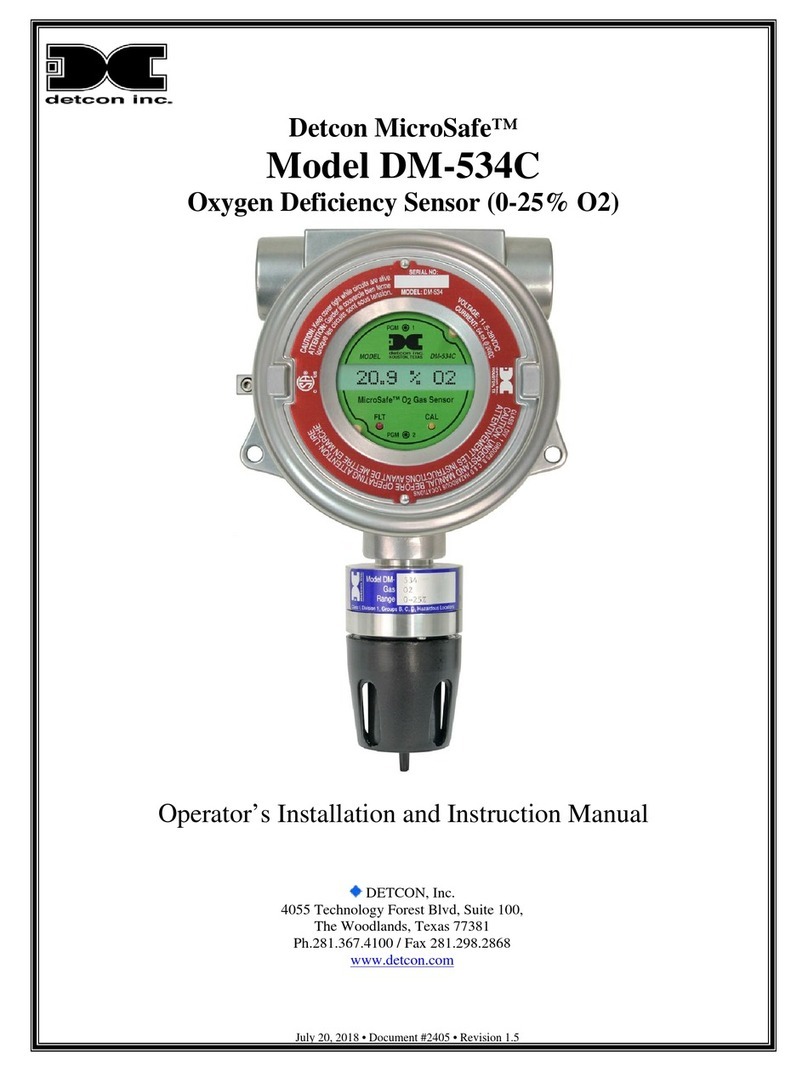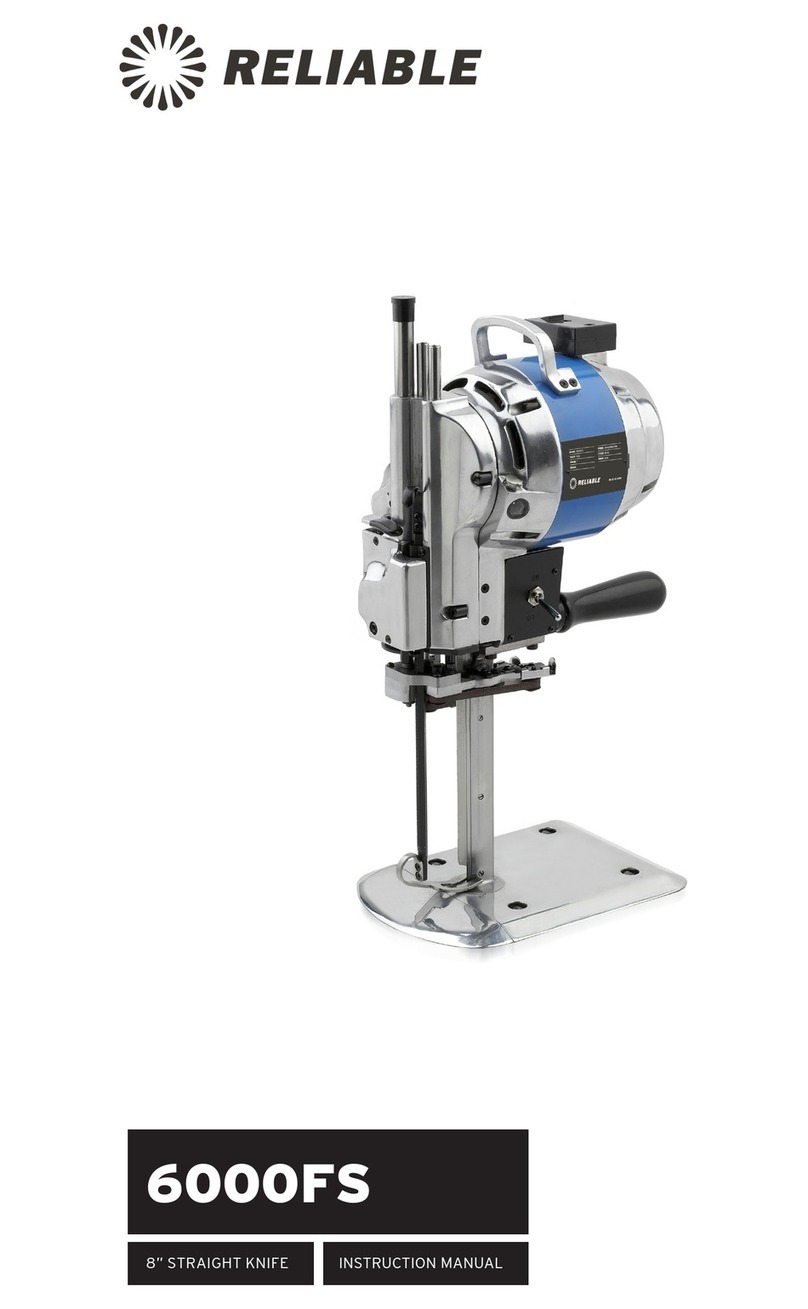Nittan evolution User manual

Document No: NISM/EV-H/04
Date: FEBRUARY 2012
evolution
EV-H–ANALOGUEADDRESSABLE
HEAT SENSOR
INSTRUCTION MANUAL
LPCB REF: 041h/01 and 041h/02
Quality System Certificate No. 041
Assessed to BS EN ISO 9001:2008
Hipley Street, Old Woking, Surrey, England, GU22 9LQ. UK
Tel: +44 (0) 1483 769555 Fax: +44 (0) 1483 756686 Web Site: www.nittan.co.uk E-mail: sales@nittan.co.uk

evolution
EV-H
ANALOGUE ADDRESSABLE
HEAT SENSOR
Ref No:
DATE:
PAGE:
NISM/EV-H/04
FEBRUARY 2012
ISSUE:
INSTRUCTION MANUAL
evolution.....
1
of
6
04
The EV-H advanced analogue addressable heat sensor forms part of a brand
new range of analogue addressable fire sensors from Nittan UK called
evolution
.
The EV-H together with the EV-PH, EV-P and EV-DP are all elegantly
designed, low profile fire sensors which are aesthetically pleasing, thus
enabling them to blend unobtrusively into modern working environments.
The
evolution
analogue addressable range all feature the very latest
technological advancements such as ASIC design, increasing reliability and
performance.
evolution...........
- BRINGING STYLE INTO FIRE DETECTION SYSTEMS
Changes
are
subject
to DCRN.
Manual: EV
-
H Manual 000018

evolution
EV-H
ANALOGUE ADDRESSABLE
HEAT SENSOR
Ref No:
DATE:
PAGE:
NISM/EV-H/04
FEBRUARY 2012
ISSUE:
INSTRUCTION MANUAL
2
of
6
04
CONTENTS:-
Section 1 - Introduction - Page 2
Section 2 - Sensor Models - Page 2
Section 3 - Base Models - Page 2
Section 4 - Installation - Page 3
Section 5 - Maintenance &
Cleaning - Page 3
Section 6 - Specifications - Page 4
Section 7 - Environmental
Parameters:- - Page 4
- Temperature - Page 4
- Humidity - Page 4
Section 8 - EMC - Page 4
Section 9 - Address Setting - Page 5
Section 10 - Connections - Page 6
Section 11 - Dimensions - Page 6
Section 12 - Heat Response Graph - Page 7
Section 1 - INTRODUCTION
The EV-H is an attractively-styled, low profile heat sensor
for use with Nittan '
evolution
' protocol control panels.
EV-H features:
* Low profile, stylish appearance
* Soft addressing
* Low monitoring current
* Supplied with protective dust cover
* Patented OMNIVIEW
TM
360
o
LED fire alarm indicator
* Remote indicator output
* 'Base Control' auxiliary output
* Compatible with UB-4-EV and STB-4SE-EV bases
*Non-polarisedterminals
* Rate of rise operation for high sensitivity model
EV-H-A1R
* Static operation for high temperature model
EV-H-CS
* Room temperature information can be separately
taken.
Section 2 - SENSOR MODELS
The EV-H heat sensor has two terminals for connection
onto the two wire loop. The remaining terminals provide a
switched current sink function which operates when the
detector goes into alarm condition, suitable for the
operation of an auxiliary function such as a remote
indicator. Terminal 3 (RIL) is limited to 3mA. Terminal 2
(Base Control) is not current limited.
Section 3 - BASE MODELS
A variety of bases are available for use with the EV-H
detectors. It is important to use the correct base for
each application. The available base models are:
i) UB-4 base: For standard use with EV-H series heat
detector when auxiliary output not used.
ii) UB-4-EV base: For standard use with EV-H series
heat detector when auxiliary output not used.
iii) STB-4SE-EV base: Similar to STB-4-EV base, except
deeper.

evolution
EV-H
ANALOGUE ADDRESSABLE
HEAT SENSOR
Ref No:
DATE:
PAGE:
NISM/EV-H/04
FEBRUARY 2012
ISSUE:
INSTRUCTION MANUAL
3
of
6
04
Section 4 - INSTALLATION
In normal use, the EV-H heat sensor will be installed at
ceiling level. Pass the field wiring through the cable hole in
the centre and from the rear of the base. Offer up and
affix the base to the ceiling or conduit fitting with screws
via the base mounting holes. Connect the field wiring to
the base terminals, as detailed on page 6 making sure the
wiring does not obstruct fitting of the sensor head.
Fit the heat sensor head by inserting it into the base and
turning clockwise until the notch in the sensor's rim aligns
with base locking screw. The OMNIVIEW
TM
360
o
LED
alarm indicator permits visibilty from any angle.
Note: The address must be set before the sensor is
fitted into place.
Fit the plastic dust cover supplied over the sensor to keep
out dust etc, until the system is commissioned. If the dust
cover is not fitted and the environment is slightly dusty,
such as when building work is being completed, for
example, problems of false alarms are likely to occur
unless cleaning of the sensor is undertaken. At
commissioning, the dust cover should be removed and
discarded.
NOTE: THE PLASTIC DUST COVER MUST BE RE-
MOVED FROM THE SENSOR IN ORDER FOR THE
SENSORTOFUNCTIONCORRECTLY.
Section 5 - MAINTENANCE AND
CLEANING
Maintenance:
The EV-H sensor is a high quality product engineered for
reliability. In order to obtain optimum performance.
periodic maintenance is required. If proper preventative
maintenance is not carried out, there is a likelihood of
malfunction, including false alarms.
Servicing:
Servicing of the system should be carried out in accord-
ance with the requirements of BS 5839 Part 1, Fire
Detection and Alarm Systems for Buildings: Code of
Practice for System Design, Installation and Servicing. The
maintenance procedures described below, should be
conductedwiththe followingfrequency:
One month after installation: Routine Inspection and
every 3 months
thereafter.
Every 6 months: OperationalTest.
Every 12 months: Functional Test and
Cleaning.
All above frequencies of maintenance are dependent on
ambient conditions.
RoutineInspection
i) Ensure the sensor head is secure and undamaged.
ii) Check the heat entry apertures are in no way
obstructed.
iii) Ensure that the surface of the sensor's outer cover is
clean. If there are deposits due to the presence of oil
vapour, dust etc, then the sensor should be cleaned in
accordance with the cleaning instructions detailed later in
this manual. It may be advisable to ensure that such
cleaning is conducted regularly in future.
iv) Ensure that no equipment which may generate exces-
sive heat has been installed in the vicinity of the sensor
since the last routine inspection. If such equipment has
been installed, then you should notify the Fire Safety
Officer or other competent authority that its presence
may cause false alarms.
Operational Test
The purpose of the Operational Test is to confirm the
sensor’s correct operation in response to a heat condi-
tion.
Note: When carrying out site testing of Analogue
Addressable Evolution sensors, the CIE shall be set to
test mode prior to beginning the tests.
i) Take any necessary precautions at the control panel to
limit the sounding of the alarm sounders/bells and any fire
service summoning device.
ii) Test the sensor with heat from a warm air gun de-
signed for heat sensor testing (e.g. 'No Climb - Solo' heat
sensor tester). Check that the sensor gives an alarm
condition within 10-20 seconds depending upon the sensor
grade and the applied air temperature. Check
that the LED indicator on the sensor illuminates.
N.B. Hot air blowers sold for paint stripping,
soldering pipes etc. generate sufficient heat to
damage the sensor and should not be used for testing
heatsensors.
iii) After the sensor has given the alarm condition, reset
the sensor from the control panel. It may be necessary
to allow a short time to elapse before resetting the
sensor, to allow any residual heat from the test to dis-
perse.
iv) Before proceeding to the next sensor, ensure that
the sensor just tested does not re-operate due to the
presence of residual heat.

evolution
EV-H
ANALOGUE ADDRESSABLE
HEAT SENSOR
Ref No:
DATE:
PAGE:
NISM/EV-H/04
FEBRUARY 2012
ISSUE:
INSTRUCTION MANUAL
4
of
6
04
FunctionalTests:
The functional test checks the sensors operation. These
sensors may be returned to our factory for Functional
Testing.
Cleaning:
Note: The sensor head should NOT be disassembled.
i) Carefully remove the heat sensor from its base.
ii) Use a soft, lint-free cloth, moistened with alcohol for
sticky deposits, to clean the plastic cover.
iii) Using a soft bristle brush (e.g. an artist's paintbrush)
carefully brush between the vanes and thermistor in a
linear motion away from the apertures on the plastic case.
iv) Ensure that no debris is left on or around the
thermistor once cleaning is complete.
v) If the unit needs further cleaning or is damaged or
corroded, please return the complete sensor to Nittan
UK. for service.
Section 6 - SPECIFICATIONS
ModelReference: - EV-H-A1R
EV-H-CS
ComputerReference: - EV-H-A1R-F15N82200
EV-H-CS-F15N82201
Sensitivity: - EV-H-A1R: Rate of rise
with 62
o
C fixed level.
EV-H-CS: Static 83
o
C.
SensorType: Thermistor of low
thermal mass
OperatingCurrent: - 200
∝
amps
fire alarm (LED on)
5.2mA
Standard: - EN54 Part 5:2000
Mass: - 118g(excluding base)
Charging Time: - 20 seconds
AmbientTemperature
Range: - -10
o
C to +55
o
C (A1R)
-10
o
C to +80
o
C (CS)
IPRating: - 42
Section 7 - ENVIRONMENTAL
PARAMETERS
TemperatureConsiderations:
Over the range from -10
o
C to +55
o
C
Humidity:
Relative Humidity of up to 95%, measured at 50
O
C, non
condensing.
Section 8 - EMC
Installation
The installation shall be in accordance with the
regulations either of the approval body for an approved
system, or otherwise, to the national code of practice/
regulations for the installation of the fire alarm system,
e.g. BS 5839 part 1.
Electromagnetic Compatibility (EMC)
On a site where there is an unusually high level of
potential electrical interference, e.g. where heavy currents
are being switched or where high levels of R.F. are
prevalent, care then must be taken in the type and
routing of cables. Particular care should be given to the
separation of zone wiring from the cable carrying the
interference.
Section 9 - ADDRESS SETTING
Use EV-AD2 Programmer for setting the address of all
devices prior to installation.

evolution
EV-H
ANALOGUE ADDRESSABLE
HEAT SENSOR
Ref No:
DATE:
PAGE:
NISM/EV-H/04
FEBRUARY 2012
ISSUE:
INSTRUCTION MANUAL
Section 10 - CONNECTIONS
5
of
6
04
RIL mustbe LED type
+
RIL
Max. current through
3 = 3mA @ 24V d.c.
Base
3
Control
3
2 2
1
+
6 1 6
_
UB-4-EVbase STB-4SE-EVbase
Auxiliary terminal RIL current limited to 3mA. Base control is not current limited as the auxiliary equipment provides
the limiting. If the +ve supply for the auxiliary equipment is taken from the EV loop, care must be taken to not cause
corruption of the EV protocol by excessive current draw.
Section 11 - DIMENSIONS
15mm
43mm
104mm

evolution
EV-H
ANALOGUE ADDRESSABLE
HEAT SENSOR
Ref No:
DATE:
PAGE:
NISM/EV-H/04
FEBRUARY 2012
ISSUE:
INSTRUCTION MANUAL
Section 12 - HEAT RESPONSE GRAPH
6
of
6
04
100
EV-H Rate of Rise Response (degree C/Min)
20 10 5 3
90
80
1
A1R
70
CS
1deg/m
60
3deg/m
5deg/m
50
10deg/m
20deg/m
40
L Limit A1
U Limit A1
30
L Limit Others
U Limit Others
20
10
0
0
5
10
15
20
25
30
35
40
45
50
Response Time (Minutes)
Table of contents
Other Nittan Accessories manuals
Popular Accessories manuals by other brands
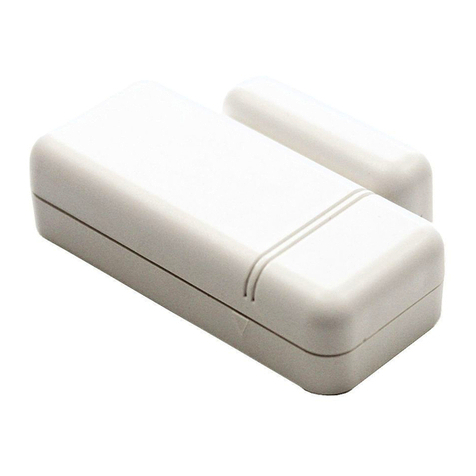
QOLSYS
QOLSYS IQ Mini Dw Extended S Line Quick install guide

Jaypro Sports
Jaypro Sports RDC SERIES Assembly & instruction manual

Craftsman
Craftsman 486.24508 Assembly instructions
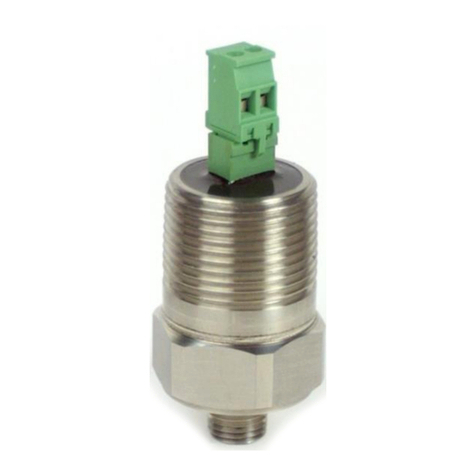
PCB Piezotronics
PCB Piezotronics IMI SENSORS HT640B71 Installation and operating manual

Giropes
Giropes Baxtran TC15 user manual

Redline Communications
Redline Communications RedMAX AN100U Administration and maintenance guide
